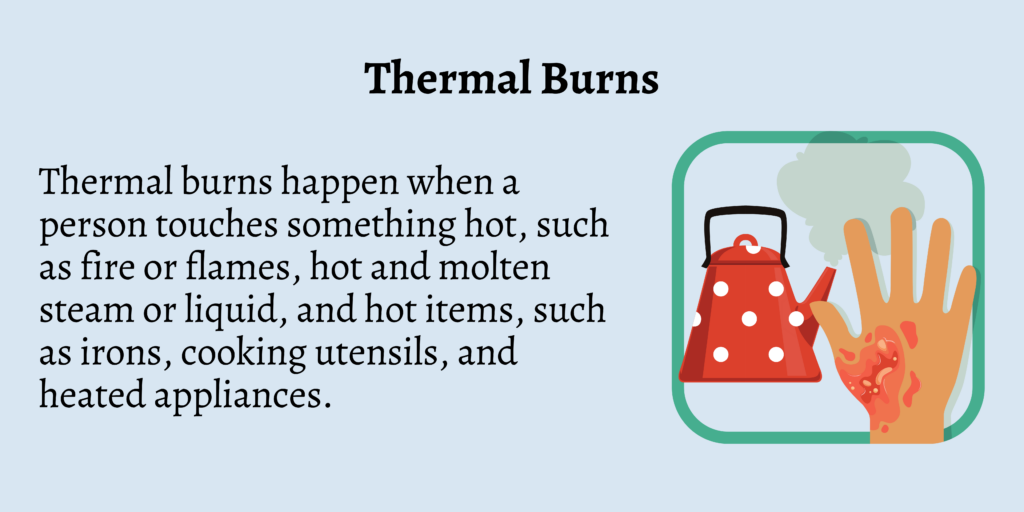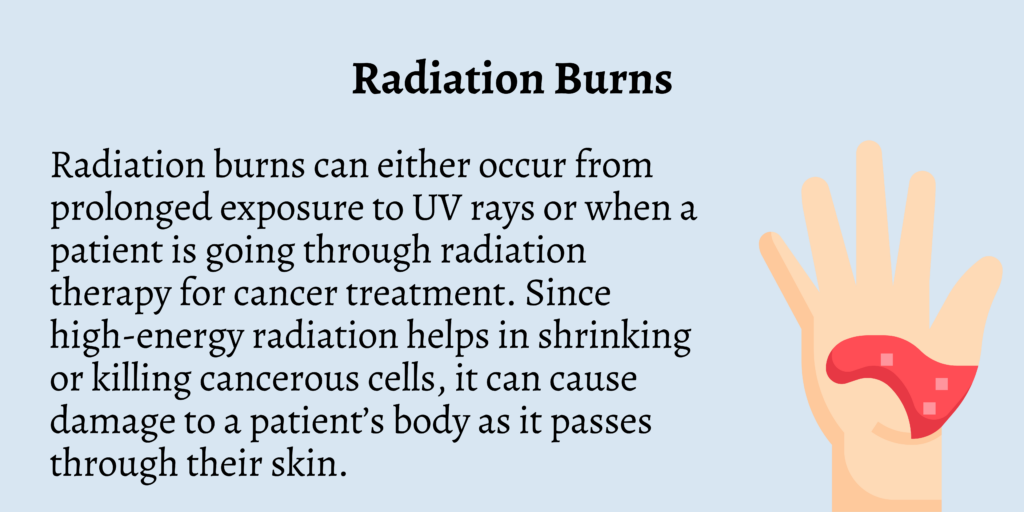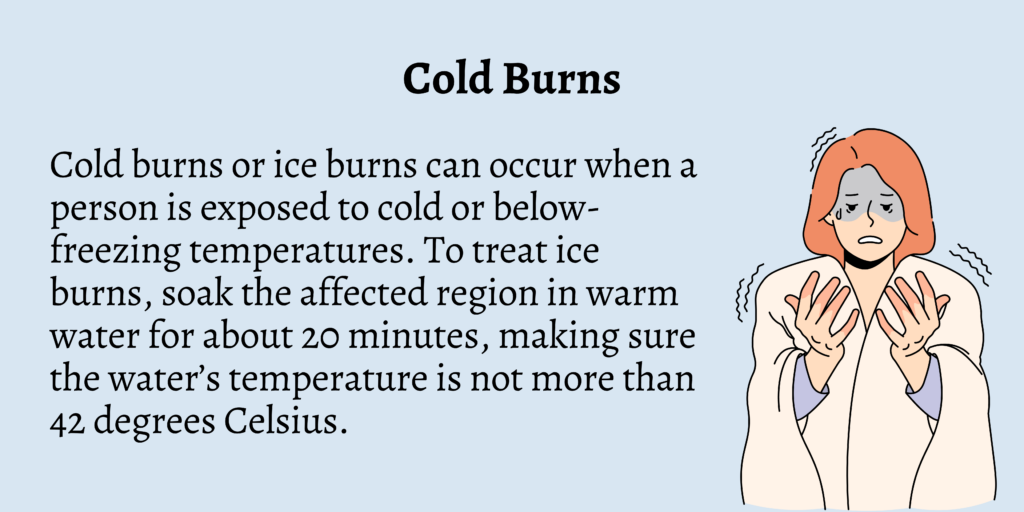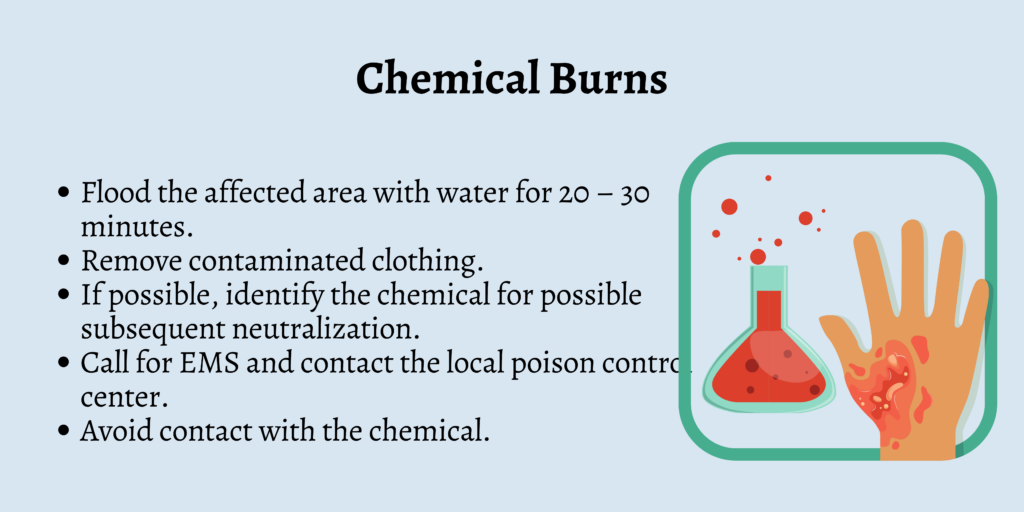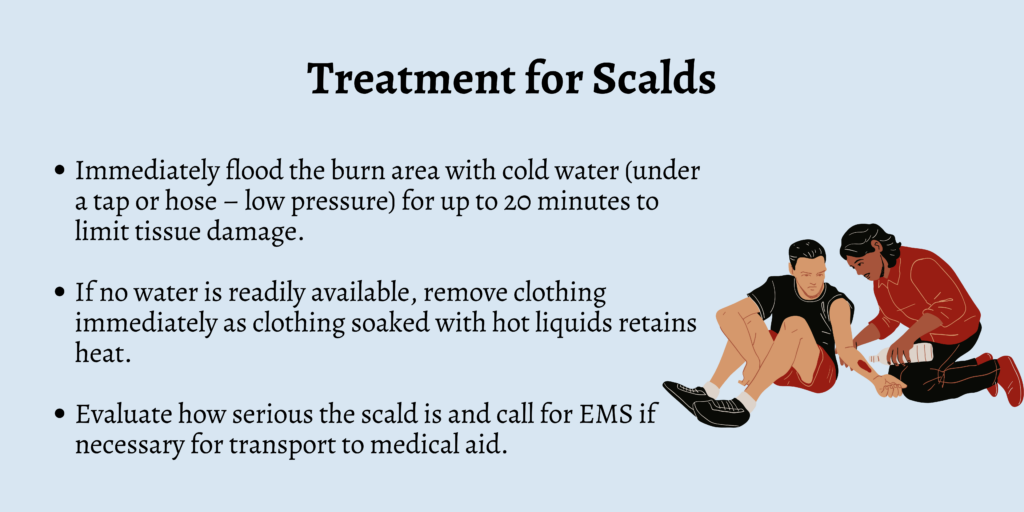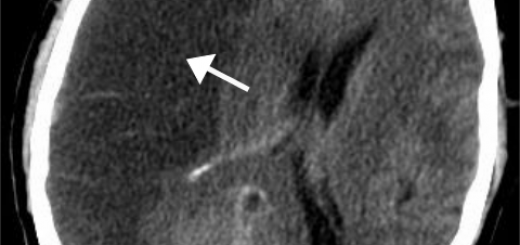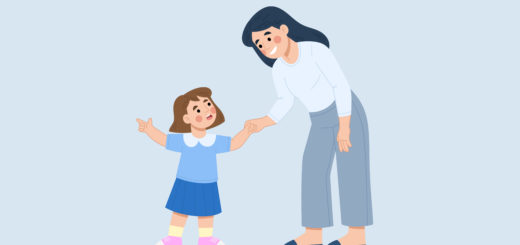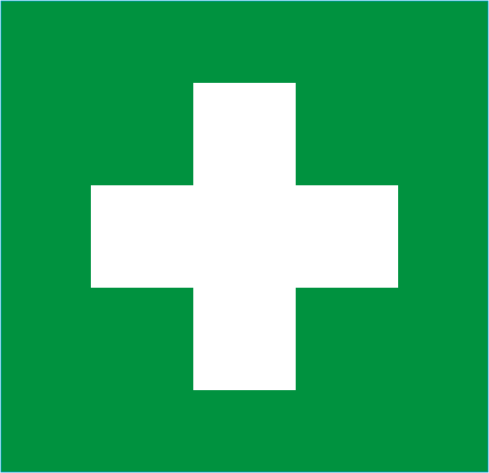First Aid for Burns and Scalds
Burns are damage caused to the body’s tissues due to factors such as heat, UV radiation, electricity, chemicals, and hot liquids. Scalds are usually caused by wet elements, such as steam or hot water. Both can be treated in the same way.In this article, we will be discussing various subjects related to burns and scalds, how to treat them, the symptoms to know about, and more.
Thermal Burns
Thermal burns happen when a person touches something hot, such as fire or flames, hot and molten steam or liquid, and hot items, such as irons, cooking utensils, and heated appliances.
These burns increase the temperature of the victim’s tissues and skin and cause charring. If someone experiences a thermal burn, help them by putting out the flames or fire and breaking their contact with the hot source.
Cool the burned region by using cold water. Make sure not to use ice in such cases, as it can damage the victim’s skin further. If the situation is mild, it can be handled through a wet and cold compress, after which the victim can use ointments or creams, as directed by a doctor.
In severe cases, loosely cover the burned area with a clean cloth or sterile bandage. Make sure the region isn’t tampered with at all till the arrival of medical help.
Radiation Burns
Radiation burns can either occur from prolonged exposure to UV rays or when a patient is going through radiation therapy for cancer treatment. Since high-energy radiation helps in shrinking or killing cancerous cells, it can cause damage to a patient’s body as it passes through their skin.
When frequent radiation treatments are involved, a person’s skin doesn’t get enough time to regenerate, thereby leading to sores and ulcers. It usually takes about two to four weeks for the healing of mild skin reactions, whereas the deeper reactions can take a couple of months to heal completely.
Radiation burns can be treated by avoiding UV exposure, wearing loose clothes, covering wounds with a bandage, cleaning them, and moisturizing them as well.
Burns from radiation therapy can also cause internal issues, which is why a patient should seek medical help immediately in such cases.
Friction Burns
Friction burns happen when a person’s skin scrapes against a hard surface or rubs against another surface. Any first-degree friction burns usually heal in about three to six days using ointments or creams. However, second-degree friction burns should be treated with medical care immediately.
Cold Burns
Cold burns or ice burns can occur when a person is exposed to cold or below-freezing temperatures. To treat ice burns, soak the affected region in warm water for about 20 minutes, making sure the water’s temperature is not more than 42 degrees Celsius.
The process of soaking can be repeated if necessary, and be sure to maintain a break of 20 minutes between each soak. Make use of warm compresses and blankets, along with treating the area with warm water.
Electrical Burns
Electric burns can be more severe than they first appear, with extensive damage to deeper tissues. They frequently show “entry” and “exit” burns at the point of contact. In the management of electrical accident casualties, the priorities are:
- Check for “Danger” & call for EMS/Rescue
- Turn off the electricity supply if possible.
- Avoid any direct contact with the skin of the casualty or any conducting material touching the casualty until he is disconnected
- Once the area is safe, check if the victim is breathing normally. If not, commence CPR.
- If the victim is conscious, treat any burns or other injuries.
Chemical Burns
- Flood the affected area with water for 20 – 30 minutes.
- Remove contaminated clothing.
- If possible, identify the chemical for possible subsequent neutralization.
- Call for EMS and contact the local poison control center.
- Avoid contact with the chemical.
There are special First Aid measures for some corrosive chemicals. Where they are used regularly, specific information should be provided for the management of accidental burns.
Burns to the Airway
If the face or front of the trunk is burnt, there could be burns to the airway – there is a risk of swelling of the air passage, leading to breathing difficulties. Medical assessment is essential because breathing difficulties may develop hours or days later.
Symptoms of Burns and Scalds
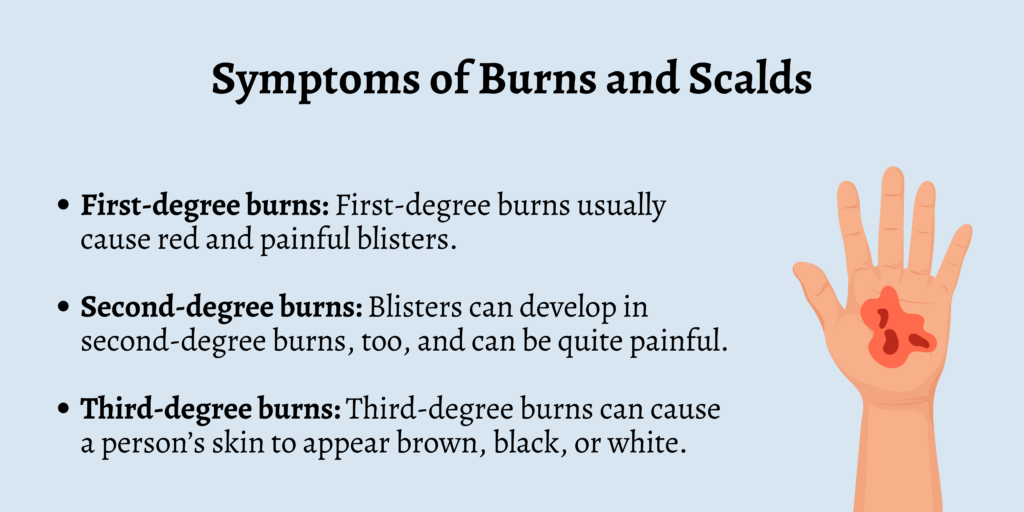
Symptoms of burns and scalds depend on the degree of damage. Accordingly, a patient can display the following symptoms:
First-degree burns: First-degree burns usually cause red and painful blisters.
Second-degree burns: Blisters can develop in second-degree burns, too, and can be quite painful. Along with swelling and scarring, the patient can also display skin that is white, red, or splotchy.
Third-degree burns: Third-degree burns can cause a person’s skin to appear brown, black, or white. The skin can develop a leathery appearance.
Causes of Burns and Scalds
Burns and scalds can be caused due to various reasons. Some of them are as follows:
· Contact with fire or flames
· Hot beverages and hot steam or water from pots, kettles, or taps
· Contact with hot appliances, such as irons, stoves, and hair straighteners or hair curlers
· Chemicals such as bleach, acids, gasoline, batteries, or drain cleaners
· Exposure to UV rays from sunlight or tanning beds
· Electrical currents
Treatment for Scalds
- Immediately flood the burn area with cold water (under a tap or hose – low pressure) for up to 20 minutes to limit tissue damage.
- If no water is readily available, remove clothing immediately as clothing soaked with hot liquids retains heat.
- Evaluate how serious the scald is and call for EMS if necessary for transport to medical aid.
Treatment for Flame Burns
- Smother the flames with a coat or blanket, get the casualty on to the floor or ground, that is, Stop, Drop and Roll.
- Prevent the victim from running if their clothing is on fire.
- If water is available, immediately cool the burn area with cold water (under a tap or hose – low pressure) for up to 20 minutes. If no water is available, remove smoldering clothing (if it is not stuck to the skin) but avoid pulling clothing across the burnt face.
- Cover the burn area with a loose, clean, dry cloth (pillow-case, handkerchief, sheet) to prevent contamination.
- Do not break blisters. Do not remove clothing that is stuck to the injury. Do not apply lotions, ointments, creams or powders – these make the assessment of a burn difficult. 6. Evaluate how serious the burn is and call EMS for transport without delay to hospital.
When to Seek Emergency Care
A patient should be taken to a hospital when:
· The burns cover their feet, hands, groin, face, buttocks, a large area of the body, or a major joint
· The burns are caused due to electricity or chemicals
· The burns make the victim’s skin look leathery, have brown or black, or white patches, or look charred
· The victim has difficulty breathing due to burns in their airways
· The burns are deep and affect deeper tissues or all the layers of the patient’s skin
· The patient displays signs of shock, such as sweating, clammy skin, dizziness, weakness, or shallow breathing
· The patient shows signs of dehydration, including headache, dry skin, thirst, nausea, lightheadedness, or decreased urination
Listed below are the cases that require immediate medical attention in terms of burns and scalds:
· The victim is a child below the age of 10
· The person has other medical conditions, such as diabetes, lung or liver disease, or heart disease
· The victim has a weakened immune system, perhaps due to HIV or chemotherapy
How to Treat Minor Burns
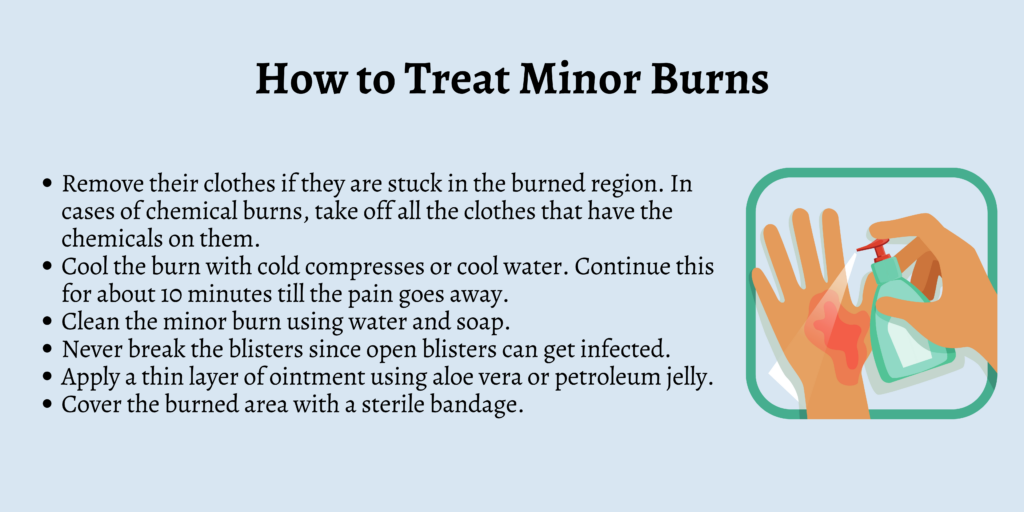
After calming the person who has suffered minor burns, proceed to do the following to treat them:
· Remove their clothes if they are stuck in the burned region. In cases of chemical burns, take off all the clothes that have the chemicals on them.
· Cool the burn with cold compresses or cool water. Continue this for about 10 minutes till the pain goes away.
· Clean the minor burn using water and soap.
· Never break the blisters since open blisters can get infected.
· Apply a thin layer of ointment using aloe vera or petroleum jelly.
· Cover the burned area with a sterile bandage.
· Get them over-the-counter pain medications.
· Protect the burned region from harmful UV rays once the area heals. Make sure they apply sunscreen with SPF 30 or higher and wear loose and protective clothing.
How to Treat Major Burns Till Help Arrives
If a person has suffered major burns, take the following steps till the arrival of the emergency medical services:
· Use a thick material to wrap the patient, such as a blanket, rug, or a coat made of cotton or wool
· Pour water on the victim
· Ensure that the patient is not touching the burning items
· Don’t remove the burned clothes that are stuck to the victim
· Make sure the victim is breathing and provide CPR if needed
· Use a clean cloth or sterile bandage to cover the burned area, making sure no ointments are applied to the region
· If the victim’s toes or fingers have been burned, separate them using sterile and dry bandages
· If a person has suffered an electrical injury, make sure not to touch them directly and instead use a non-metallic object to move them away from any exposed wires before administering any first aid
Conclusion
Burns and scalds can be prevented by being careful. Whenever you use an electrical item, make sure to unplug it after using it. If you’re using chemicals such as cleaning agents, always wear protective clothing and gear to ensure they don’t spill on you.
Check the temperature of the water before washing your hands or taking a bath. Ensure to install smoke detectors in your home and keep a fire extinguisher around in cases of emergencies.
When you come across a person who has been burned in some way, use the necessary measures to help them, be it covering them with a blanket, turning off the electricity, or taking off contaminated clothes and washing the affected area of the body.

